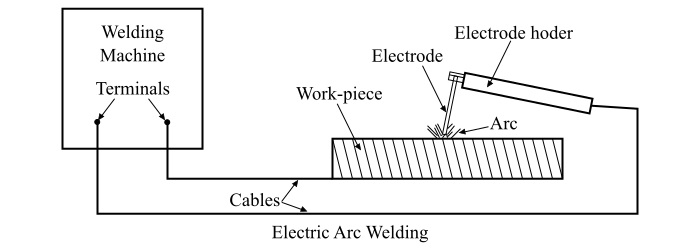
 Data Structure
Data Structure Networking
Networking RDBMS
RDBMS Operating System
Operating System Java
Java MS Excel
MS Excel iOS
iOS HTML
HTML CSS
CSS Android
Android Python
Python C Programming
C Programming C++
C++ C#
C# MongoDB
MongoDB MySQL
MySQL Javascript
Javascript PHP
PHP
- Selected Reading
- UPSC IAS Exams Notes
- Developer's Best Practices
- Questions and Answers
- Effective Resume Writing
- HR Interview Questions
- Computer Glossary
- Who is Who
Electric Arc Welding: Working Principle, Types, and Applications
What is Electric Arc Welding?
The process of welding in which heat is produced by creating an electric arc to join metal workpieces is known as electric arc welding.
Electric arc welding is a type of welding that uses a welding power supply to create an electric arc between a metal stick, called electrode, and the workpiece to melt the metals at the point of contact.
Electric arc welding can use either DC supply or AC supply and a consumable or non-consumable electrode.
Working Principle of Electric Arc Welding
The process of electric arc welding is based on the principle that, when electric current is passed through an air gap from one electric conductor to another, then an electric arc is produced which generates a very intense and concentrated heat.
The temperature of the arc between two conductors is approximately 3500 °C to 4000 °C. This high temperature generates intense heat in the arc at the point of welding, which melts a small portion of metal in the work-piece.
The electric arc keeps this molten metal pool agitated and the base metal is thoroughly mixed with melted electrode metal, after that the metal pool cools down under a protective cover of slag left by the electrode. On cooling, a strong weld join is formed between the two metal pieces.
A simplified circuit of electric arc welding is shown in the figure.

In electric arc welding, either AC or DC current is obtained from a welding power supply. Here, one terminal is connected to the electrode mounted on an electrode holder, which is held by the welder, while the other terminal is connected to the workpiece and the circuit is completed through an air gap between the electrode and the work-piece.
The length of the air gap (i.e., distance between electrode tip and the surface of the work-piece) is about 3 mm to 6 mm. The welding is done by creating an electric arc between the electrode and the workpiece. The temperature of the arc is very high (about 3500 °C to 4000 °C) and the metal in contact with the arc becomes molten which enables a weld to be melt. The electrode is then moved slowly in the desired direction to complete the weld.
Types of Electric Arc Welding
The electric arc welding is mainly classified into following types −
DC Metallic Arc Welding
AC Metallic Arc Welding
Carbon Arc Welding
Atomic Hydrogen Arc Welding
Shielded Arc Welding
Advantages of Arc Welding
Some of the chief advantages of the electric arc welding are given as follows −
The electric arc welding is the suitable welding process for high speed welds.
Apparatus required for arc welding is very simple and portable.
The electric arc welding gives superior temperature at the point of welding.
Electric arc welding can work on both AC and DC supply.
It is inexpensive to install.
Disadvantages of Electric Arc Welding
The disadvantages of electric arc welding are as follows −
The welding process with electric arc welding requires skilled operators.
Electric arc welding cannot be used for welding of reactive metals such as aluminium, titanium, etc.
Electric arc welding is not suitable for welding thin metals.
Applications of Electric Arc Welding
The important applications of electric arc welding are as follows −
Electric arc welding is used in repairing of broken parts of machines.
It is used for welding of cast iron or steel housings and frames.
Electric arc welding is used in various industries such as automotive industries, construction industries, mechanical industries, etc.
Electric welding is also used for welding process in shipbuilding.

